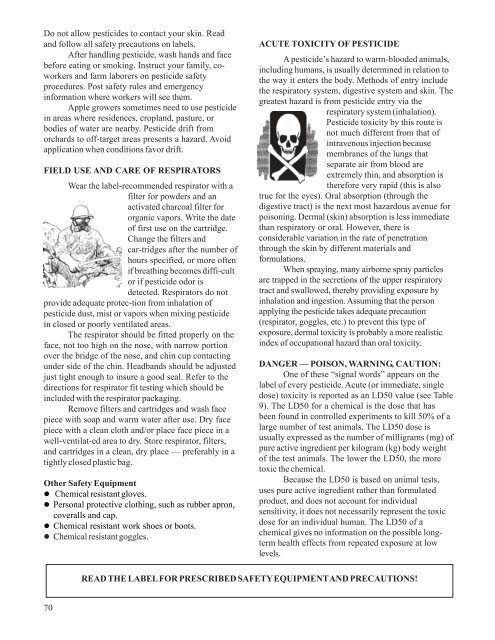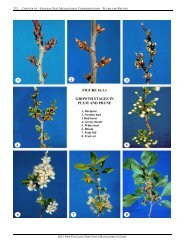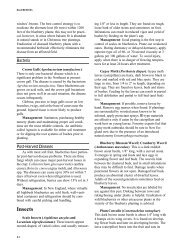Acute Toxicity of Pesticides (Table 9)
Acute Toxicity of Pesticides (Table 9)
Acute Toxicity of Pesticides (Table 9)
Create successful ePaper yourself
Turn your PDF publications into a flip-book with our unique Google optimized e-Paper software.
Do not allow pesticides to contact your skin. Read<br />
and follow all safety precautions on labels.<br />
After handling pesticide, wash hands and face<br />
before eating or smoking. Instruct your family, coworkers<br />
and farm laborers on pesticide safety<br />
procedures. Post safety rules and emergency<br />
information where workers will see them.<br />
Apple growers sometimes need to use pesticide<br />
in areas where residences, cropland, pasture, or<br />
bodies <strong>of</strong> water are nearby. Pesticide drift from<br />
orchards to <strong>of</strong>f-target areas presents a hazard. Avoid<br />
application when conditions favor drift.<br />
FIELD USE AND CARE OF RESPIRATORS<br />
Wear the label-recommended respirator with a<br />
filter for powders and an<br />
activated charcoal filter for<br />
organic vapors. Write the date<br />
<strong>of</strong> first use on the cartridge.<br />
Change the filters and<br />
car-tridges after the number <strong>of</strong><br />
hours specified, or more <strong>of</strong>ten<br />
if breathing becomes diffi-cult<br />
or if pesticide odor is<br />
detected. Respirators do not<br />
provide adequate protec-tion from inhalation <strong>of</strong><br />
pesticide dust, mist or vapors when mixing pesticide<br />
in closed or poorly ventilated areas.<br />
The respirator should be fitted properly on the<br />
face, not too high on the nose, with narrow portion<br />
over the bridge <strong>of</strong> the nose, and chin cup contacting<br />
under side <strong>of</strong> the chin. Headbands should be adjusted<br />
just tight enough to insure a good seal. Refer to the<br />
directions for respirator fit testing which should be<br />
included with the respirator packaging.<br />
Remove filters and cartridges and wash face<br />
piece with soap and warm water after use. Dry face<br />
piece with a clean cloth and/or place face piece in a<br />
well-ventilat-ed area to dry. Store respirator, filters,<br />
and cartridges in a clean, dry place — preferably in a<br />
tightly closed plastic bag.<br />
Other Safety Equipment<br />
• Chemical resistant gloves.<br />
• Personal protective clothing, such as rubber apron,<br />
coveralls and cap.<br />
• Chemical resistant work shoes or boots.<br />
• Chemical resistant goggles.<br />
ACUTE TOXICITY OF PESTICIDE<br />
A pesticide’s hazard to warm-blooded animals,<br />
including humans, is usually determined in relation to<br />
the way it enters the body. Methods <strong>of</strong> entry include<br />
the respiratory system, digestive system and skin. The<br />
greatest hazard is from pesticide entry via the<br />
respiratory system (inhalation).<br />
Pesticide toxicity by this route is<br />
not much different from that <strong>of</strong><br />
intravenous injection because<br />
membranes <strong>of</strong> the lungs that<br />
separate air from blood are<br />
extremely thin, and absorption is<br />
therefore very rapid (this is also<br />
true for the eyes). Oral absorption (through the<br />
digestive tract) is the next most hazardous avenue for<br />
poisoning. Dermal (skin) absorption is less immediate<br />
than respiratory or oral. However, there is<br />
considerable variation in the rate <strong>of</strong> penetration<br />
through the skin by different materials and<br />
formulations.<br />
When spraying, many airborne spray particles<br />
are trapped in the secretions <strong>of</strong> the upper respiratory<br />
tract and swallowed, thereby providing exposure by<br />
inhalation and ingestion. Assuming that the person<br />
applying the pesticide takes adequate precaution<br />
(respirator, goggles, etc.) to prevent this type <strong>of</strong><br />
exposure, dermal toxicity is probably a more realistic<br />
index <strong>of</strong> occupational hazard than oral toxicity.<br />
DANGER — POISON, WARNING, CAUTION:<br />
One <strong>of</strong> these “signal words” appears on the<br />
label <strong>of</strong> every pesticide. <strong>Acute</strong> (or immediate, single<br />
dose) toxicity is reported as an LD50 value (see <strong>Table</strong><br />
9). The LD50 for a chemical is the dose that has<br />
been found in controlled experiments to kill 50% <strong>of</strong> a<br />
large number <strong>of</strong> test animals. The LD50 dose is<br />
usually expressed as the number <strong>of</strong> milligrams (mg) <strong>of</strong><br />
pure active ingredient per kilogram (kg) body weight<br />
<strong>of</strong> the test animals. The lower the LD50, the more<br />
toxic the chemical.<br />
Because the LD50 is based on animal tests,<br />
uses pure active ingredient rather than formulated<br />
product, and does not account for individual<br />
sensitivity, it does not necessarily represent the toxic<br />
dose for an individual human. The LD50 <strong>of</strong> a<br />
chemical gives no information on the possible longterm<br />
health effects from repeated exposure at low<br />
levels.<br />
READ THE LABEL FOR PRESCRIBED SAFETY EQUIPMENT AND PRECAUTIONS!<br />
70
<strong>Table</strong> 9 – <strong>Acute</strong> <strong>Toxicity</strong> <strong>of</strong> Apple <strong>Pesticides</strong>.<br />
LD50 for test animals<br />
(mg technical chemical<br />
per kg body weight)<br />
Chemical<br />
Oral (Rat) Dermal (Rabbit)<br />
acetamiprid (Assail) 417 > 2,000<br />
abamectin (Agri-Mek) 300 > 1,800<br />
AVG (ReTain) > 1,840 > 2,000<br />
azadirachtin (Neemix) > 5,000 > 2,000<br />
azinphosmethyl (Guthion) 4 150-200<br />
Bacillus thuringiensis toxin nontoxic<br />
basic copper sulfate (Basicop, etc.) 472 ---<br />
benomyl (Benlate) > 10,000 >10,000<br />
benzyladenine (Accel) 1,300-2,125 ---<br />
Bifenazate (Acaramite) > 5,000 > 2,000<br />
captan 9,000 --- 1<br />
carbaryl (Sevin) 246 ---<br />
chlorophacinone (Rozol) 3 ---<br />
chlorpyrifos (Lorsban) 96-270 2,000<br />
cinnamaldehyde (Valero) --- ---<br />
cl<strong>of</strong>entezine (Apollo) > 3,200 ---<br />
copper hydroxide (Kocide) 1,000 ---<br />
copper oxychloride (COCS) 1,131 > 2,000<br />
cyprodinil (Vangard) > 5,000 > 2,000<br />
dazomet (Basamid) 519 > 2,000<br />
diazinon 1,250 > 2,020<br />
dichlobenil (Casoron) > 4,460 > 2,000<br />
dic<strong>of</strong>ol (Kelthane) 570 2,000-5,000<br />
dimethoate (Digon) 235 400<br />
diphacinone (Ramik) 7 ---<br />
diuron (Direx, Karmex) > 5,000 > 5,000<br />
dodine (Syllit) 1,000 1,500<br />
endosulfan (Thiodan, Phaser) 160 359<br />
esfenvalerate (Asana XL) 458 > 2,000<br />
ethephon (Ethrel) 3,030 1,560<br />
fenamiphos (Nemacur) 11 71<br />
fenarimol (Rubigan) 2,500 ---<br />
fenbutatin-oxide (Vendex) 2,631 > 2,000<br />
fenpropathrin (Danitol) 71 > 2,000<br />
ferbam (Ferbam Granuflo) > 5,000 > 4,000<br />
fluazifop-butyl (Fusilade) 3,328 ---<br />
formetanate HCl (Carzol) 15-26 >10,000<br />
fosetyl-Al (Aliette) 5,000 > 2,000<br />
glufosinate-ammonium (Rely) 2,000 > 4,000<br />
glyphosate (Roundup) > 5,000 > 5,000<br />
hexythiazox (Savey) > 5,000 > 5,000<br />
imidacloprid (Provado) 450 > 5,000<br />
indoxacarb (avaunt) 687 > 5,000<br />
insecticidal soap (M-Pede) 16,900 > 5,000<br />
kresoxim-methyl (Sovran) > 5,000 > 2,000<br />
mancozeb (Dithane, etc.) 11,200 >15,000<br />
LD50 for test animals<br />
(mg technical chemical<br />
per kg body weight)<br />
Chemical Oral (Rat) Dermal (Rabbit)<br />
maneb (Manex) 7,990 > 5,000<br />
metalaxyl (Ridomil) 669 > 3,100<br />
methidathion (Supracide) 44 200 1<br />
methomyl (Lannate) 17-24 5,880<br />
methoxyfenozide (Intrepid) > 5,000 > 5,000<br />
metiram (Polyram) > 6,810 > 2,000<br />
myclobutanil (Nova) 1,600 > 5,000<br />
NAA (Fruitone-N, K-Salt Fruit Fix) 1,000 ---<br />
NAD (Amid-thin) 1,690 > 2,000<br />
napropamide (Devrinol) > 500 ---<br />
norflurazon (Solicam) > 8,000 >20,000<br />
oil (refined petroleum distillate) > 15,000 > 5,000<br />
oryzalin (Surflan) > 10,000 ---<br />
oxamyl (Vydate) 5 2,960<br />
oxyfluorfen (Goal) > 5,000 >10,000<br />
paraquat (Gramoxone Extra) 150 --- 1<br />
pendimethalin (Prowl) 3,956 > 2,200<br />
permethrin (Ambush, Pounce) 430-4,000 > 2,000<br />
phosmet (Imidan) 147-316 > 4,640<br />
promalin (Promalin) 5,050 5,050<br />
pronamide (Kerb) 8,350 > 3,160<br />
pyrethrum 1,500 > 1,800<br />
pyrethrin & rotenone (Pyrellin EC) 1,500 ---<br />
pyridaben (Pyramite) 820-1,930 > 2,000<br />
pyriproxyfen (Esteem) > 5,000 > 2,000<br />
rotenone 132–1,500 ---<br />
sethoxydim (Poast) 3,200 > 5,000<br />
simazine (Princep) >5,000 > 3,100<br />
sodium methyldithiocarbamate 812 > 2000<br />
(Vapam)<br />
spinosad (SpinTor) >5,000 > 5,000<br />
streptomycin (AgriMycin) 9,000 --- 2<br />
sulfosate (Touchdown) 750 > 200 1<br />
sulfur > 5,000 > 5,000 2<br />
tebufenozide (Confirm) > 5,000 > 5,000<br />
terbacil (Sinbar) 5,000 ---<br />
thiabendazole (Mertect 340-F) 3,100 ---<br />
thiophanate-methyl (Topsin M) 7,500 ---<br />
thiram 1,000 > 5,000 1<br />
triadimefon (Bayleton) 1,000 > 5,000<br />
triflumizole (Procure) 1,057 > 5,000<br />
trifloxystrobin (Flint) > 4,000 > 2,000<br />
zinc phosphide 46 ---<br />
ziram 1,400 > 6,000<br />
2,4-D (Amine 4, Saber) 500-949 ---<br />
--- = unknown; > = greater than; 1 - Irritating to skin, mucous membranes; 2 - May cause skin reaction.<br />
Note: Chemicals for which at least one formulation carries the DANGER signal word because <strong>of</strong> acute toxicity or other<br />
hazard are in bold letters. Different formulations <strong>of</strong> the same active ingredient can have different signal words.<br />
71
<strong>Toxicity</strong> Category LD50 Oral LD50 Dermal<br />
& Signal Word (mg active ing. (mg active ing.<br />
on Label per kg body weight) per kg body wt.)<br />
I DANGER 0 to 50 0 to 200<br />
POISON<br />
II WARNING >50 to 500 >200 to 2,000<br />
III CAUTION* >500 to 5,000 >2,000 to 20,000<br />
IV none* >5,000 > 20,000<br />
* Category IV material may have Caution signal<br />
word due to skin irritation or other hazard.<br />
In addition to oral or dermal acute toxicity, a<br />
pesticide may also carry the DANGER — POISON,<br />
DANGER, or WARNING signal words because <strong>of</strong><br />
other potential hazards, such as inhalation toxicity or the<br />
ability to cause severe eye or skin damage<br />
LABEL COMPLIANCE<br />
Under the present EPA regulations, pesticides<br />
may be applied:<br />
• at a different rate per 100 gallons dilute than stated<br />
on label as long as the application stays within the<br />
dose per acre limit;<br />
• at a lower rate per acre than on label; and<br />
• less frequently than on label.<br />
IMPORTANT — it is illegal to:<br />
• increase amount applied per acre (overdosage);<br />
• use shorter intervals between sprays than minimum<br />
interval stated on label; and<br />
• shorten intervals to harvest (illegal residues on<br />
crop).<br />
State regulations may be more restrictive than those <strong>of</strong><br />
the EPA.<br />
PROTECTING WATER QUALITY<br />
Apple growers have a responsibility to prevent<br />
pesticide from contaminating surface bodies <strong>of</strong> water<br />
and groundwater supplies. Over 90% <strong>of</strong> the rural<br />
population in the U.S. depends on groundwater as<br />
their supply <strong>of</strong> drinking water. Groundwater is very<br />
difficult to clean if it does become polluted. Listed<br />
below are a few practices that can help prevent water<br />
contamination. Contact Extension for more<br />
information.<br />
• Consider the potential for rinse water, spills,<br />
application or erosion to create pesticide laden run<strong>of</strong>f<br />
which can reach a surface body <strong>of</strong> water. If<br />
you do not have a self-contained mixing pad, use<br />
an area where the run-<strong>of</strong>f risk is low. If you are<br />
working near a stream or pond, do not allow run<strong>of</strong>f<br />
to occur.<br />
• Use an anti-backflow device when filling the spray<br />
tank.<br />
• Periodically change the location <strong>of</strong> field mixing<br />
areas. Be aware <strong>of</strong> the location and condition <strong>of</strong><br />
wells, stay at least 50 feet away from wells.<br />
Special caution is needed around wells with<br />
cracked casings.<br />
• Be aware <strong>of</strong> the soil types, geology, and depth <strong>of</strong><br />
water table in your local area. The potential for<br />
pesticide leaching into groundwater is generally<br />
greater on ledge, sandy soils, or other soils low in<br />
organic matter. The risk increases when the water<br />
table is close to the surface. Try to choose<br />
pesticides with a low leachability hazard if you are<br />
working under these conditions.<br />
• Keep spray equipment accurately calibrated.<br />
• Use proper procedures for pesticide storage and<br />
disposal. Keep pesticide storage and mixing areas<br />
away from streams, ponds, and springs.<br />
RESTRICTED ENTRY INTERVAL<br />
The REI values listed in <strong>Table</strong> 10 are the best<br />
information available as <strong>of</strong> November 2002.<br />
Manufacturers may write the label with a longer REI<br />
than required by the EPA, or the EPA may change<br />
its minimum REI requirement. To know the use<br />
restrictions for a pesticide you must READ THE<br />
LABEL!<br />
PESTICIDE RESIDUE TOLERANCES<br />
Federal laws warn that food shipments bearing<br />
residues <strong>of</strong> pesticide chemicals in excess <strong>of</strong> established<br />
tolerances will be contraband and subject to seizures as<br />
“adulterated.” This applies to both raw and processed<br />
foods.<br />
The amount <strong>of</strong> pesticide residue in or on a<br />
food material at harvest must fall into established<br />
tolerances, expressed in “parts per million” (ppm). The<br />
actual amount <strong>of</strong> pesticide chemical found in a food at<br />
harvest depends in part on the amount applied to the<br />
crop and the length <strong>of</strong> time since the last application.<br />
Therefore, growers are responsible for strictly<br />
following label information as to:<br />
• maximum spray dosage, and<br />
• the preharvest interval: which is time between the<br />
final pesticide application and harvest.<br />
The FDA advises pesticide users to follow<br />
directions on recently registered labels, so they do not<br />
exceed the residue tolerance for any material. Use the<br />
following table as a general guide, but verify the<br />
preharvest interval by checking the label before using the<br />
product. <strong>Table</strong> 10 refers to use on apples only.<br />
72







